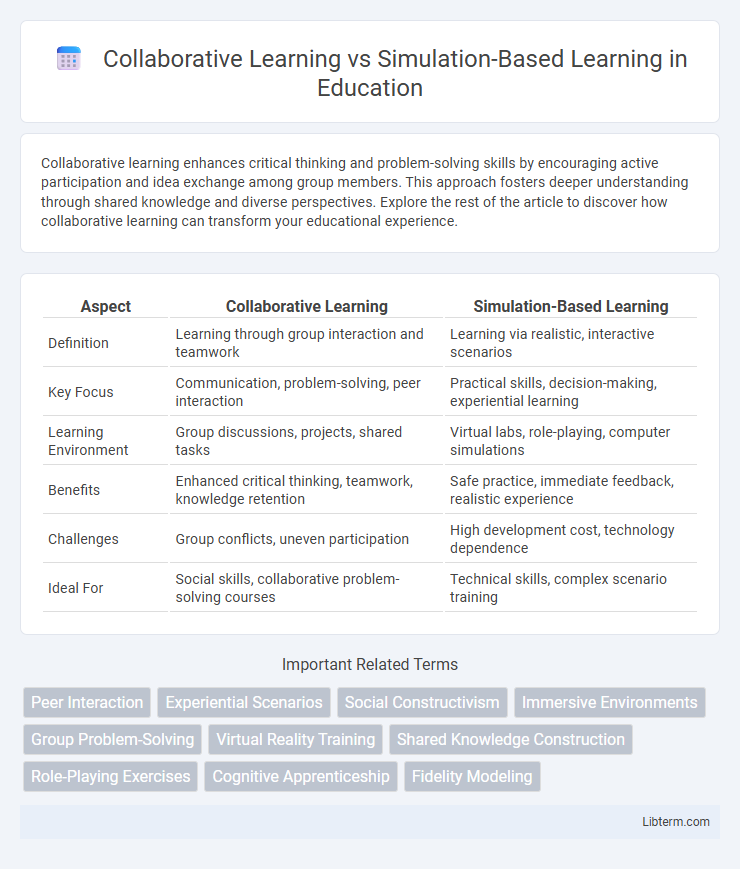Collaborative learning enhances critical thinking and problem-solving skills by encouraging active participation and idea exchange among group members. This approach fosters deeper understanding through shared knowledge and diverse perspectives. Explore the rest of the article to discover how collaborative learning can transform your educational experience.
Table of Comparison
| Aspect | Collaborative Learning | Simulation-Based Learning |
|---|---|---|
| Definition | Learning through group interaction and teamwork | Learning via realistic, interactive scenarios |
| Key Focus | Communication, problem-solving, peer interaction | Practical skills, decision-making, experiential learning |
| Learning Environment | Group discussions, projects, shared tasks | Virtual labs, role-playing, computer simulations |
| Benefits | Enhanced critical thinking, teamwork, knowledge retention | Safe practice, immediate feedback, realistic experience |
| Challenges | Group conflicts, uneven participation | High development cost, technology dependence |
| Ideal For | Social skills, collaborative problem-solving courses | Technical skills, complex scenario training |
Introduction to Collaborative and Simulation-Based Learning
Collaborative learning emphasizes peer interaction and teamwork to enhance critical thinking, problem-solving, and communication skills through shared knowledge construction. Simulation-based learning employs realistic scenarios and virtual environments to provide hands-on experience, allowing learners to experiment, practice decision-making, and develop practical skills in a risk-free setting. Both methods foster active engagement and experiential learning, crucial for professional development across various educational and training fields.
Core Principles of Collaborative Learning
Collaborative learning centers on active student participation, emphasizing group interaction where learners share knowledge, solve problems collectively, and develop critical thinking skills through dialogue. Key principles include positive interdependence, individual accountability, promotive interaction, social skills development, and group processing. This approach contrasts with simulation-based learning, which relies on immersive, experiential scenarios to enhance decision-making and technical abilities.
Key Elements of Simulation-Based Learning
Simulation-based learning hinges on immersive, scenario-driven environments that replicate real-world challenges, enabling learners to practice skills and decision-making in a risk-free setting. Key elements include realistic context, interactive technology, feedback mechanisms, and opportunities for reflection and debriefing that reinforce knowledge retention and application. Unlike collaborative learning, which emphasizes group interaction and shared knowledge construction, simulation-based learning centers on experiential practice and individual competency within controlled simulations.
Comparing Learning Outcomes
Collaborative learning enhances critical thinking, communication, and teamwork skills by engaging learners in group problem-solving, which fosters deeper understanding through peer interaction. Simulation-based learning offers immersive, experiential training that improves decision-making, practical application, and retention of complex skills in realistic scenarios. Studies show that combining both approaches can maximize learning outcomes by integrating social learning dynamics with hands-on experiences.
Engagement and Motivation in Both Approaches
Collaborative learning enhances engagement by fostering peer interaction and shared problem-solving, which boosts intrinsic motivation through social connectivity. Simulation-based learning increases motivation by providing immersive, hands-on experiences that replicate real-world scenarios, encouraging active participation and immediate feedback. Both approaches leverage active involvement but engage different motivational drivers: social collaboration versus experiential realism.
Technology Integration: Tools and Platforms
Collaborative learning utilizes technology platforms like Google Workspace, Microsoft Teams, and Slack to facilitate real-time communication, file sharing, and group projects, enhancing teamwork and collective problem-solving skills. Simulation-based learning leverages advanced tools such as virtual reality (VR) software, simulation labs, and platforms like Labster or Simul8 to create immersive, interactive scenarios that replicate real-world environments for experiential learning. Both approaches integrate Learning Management Systems (LMS) such as Moodle and Blackboard to track progress, deliver content, and support blended learning environments.
Assessment Methods: Collaborative vs Simulation-Based
Assessment methods in collaborative learning emphasize peer evaluations, group projects, and continuous feedback, fostering social interaction and collective problem-solving skills. Simulation-based learning assessments often involve scenario performance metrics, real-time decision tracking, and objective skill demonstrations within virtual or controlled environments. Both approaches prioritize applied knowledge but differ in evaluation focus: collaborative learning stresses interpersonal dynamics, while simulation-based learning measures individual competency in simulated contexts.
Best Practices for Implementation
Effective implementation of collaborative learning involves structured group activities that promote peer interaction, clear objectives, and continuous facilitator support to enhance knowledge retention and critical thinking. Simulation-based learning requires realistic scenario design, immediate feedback, and opportunities for reflection to improve decision-making skills and practical application. Combining both methods can maximize engagement and deepen understanding by leveraging teamwork dynamics alongside experiential practice.
Challenges and Limitations
Collaborative learning often faces challenges such as coordinating schedules, managing group dynamics, and ensuring equal participation, which can hinder effective knowledge sharing among students. Simulation-based learning is limited by high costs, technical difficulties, and the need for specialized equipment or software, potentially restricting accessibility and scalability. Both methods require significant instructor facilitation to overcome barriers related to student engagement and realism in learning scenarios.
Future Trends in Educational Methodologies
Future trends in educational methodologies emphasize the integration of collaborative learning and simulation-based learning to enhance engagement and skill acquisition. Collaborative learning harnesses social interaction and peer feedback to develop critical thinking and teamwork skills, while simulation-based learning offers immersive, experiential environments for practical application in fields like healthcare and engineering. Advancements in artificial intelligence and virtual reality are expected to further personalize and expand these methods, creating adaptive, interactive platforms that optimize learning outcomes and prepare students for real-world challenges.
Collaborative Learning Infographic

 libterm.com
libterm.com